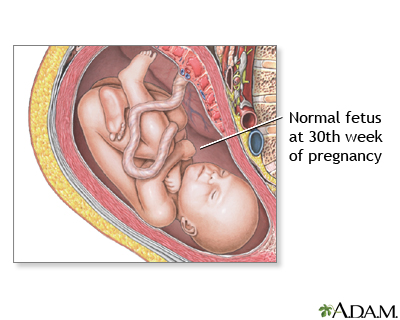| ||||||||||||||||||||||||||||||||||||||||

Your baby continues to grow taller and fill out as you near the end of your pregnancy. By now, the baby weighs about 3 pounds (1400 g) and measures about 17 inches (38 cm) in total length. Your baby is continuing to grow rapidly now. In preparation for the journey to the new world, baby is taking deep breaths of fluid in the amniotic sac. Sometimes at this point the baby may get hiccups that you can feel!
Chances are you have a lot on your mind as you settle into the last trimester. And like most pregnant women, you're probably pondering what's best for your baby food wise: breast or bottle? Doctors and midwives agree that breastfeeding is the best choice for your baby, and also has significant benefits for your health too. It's best to start out breastfeeding. If you start out bottle-feeding and then want to try breastfeeding, you may find your milk has dried up, and it will be too late. Read on to understand why breastfeeding is such a great option.
Breast really is best for many reasons.
Keep these things in mind when breastfeeding:
You may think that bottle feeding may be more convenient because others can help feed, but there are a number of downsides:
It's best to start out nursing your baby and not use a bottle so you and your baby can figure out how to nurse. After the first few weeks, women who want to both breast and bottle feed often introduce a bottle, so that baby can learn how to feed both ways. If you need to return to work, or be separated from your baby, you can express your milk with a pump and store it for future use. Talk with your health care provider about proper breastmilk storage.
Talk it over with your doctor and your partner and come up with a plan that seems the most reasonable for you, your baby, and your partner.
Get a glimpse inside your swelling belly and see how babies grow and change with this ultrasound identifier visual tool. These dynamic images will show you what a fetus looks like at 17, 19, and 30 weeks. Just roll the curser over the different body parts, and presto!
If getting comfortable in bed at night is getting more and more difficult, bring on the pillows and props. You can put a maternity pillow (really any pillow will do) between your legs, under your belly, and behind your back. To relieve pressure on your hips from lying on your side, tuck a piece of soft egg-crate foam on top of your mattress and under the sheet, and to ease fluid retention in your legs and ankles, place a folded blanket under your feet to keep them elevated while you sleep.
|
Review Date:
8/20/2019 Reviewed By: LaQuita Martinez, MD, Department of Obstetrics and Gynecology, Emory Johns Creek Hospital, Alpharetta, GA. Also reviewed by David Zieve, MD, MHA, Medical Director, Brenda Conaway, Editorial Director, and the A.D.A.M. Editorial team. |